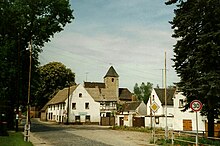Great Grimma
Großgrimma was a municipality in the former district of Weißenfels in the state of Saxony-Anhalt . On July 1, 1998, Großgrimma was incorporated into the town of Hohenmölsen . The place Großgrimma has meanwhile been devastated and demolished. The municipalities also included the demolished villages of Grunau , Bösau, Domsen , Mödnitz and Deumen.
history
Großgrimma and its former five districts, like the neighboring towns of Steingrimma , Queisau and Köttichau, belonged to the Electorate of Saxony and the Kingdom of Saxony until 1815 . Großgrimma, Deumen, Domsen, Grunau and Bösau were located in the east of the Electoral Saxon office of Weißenfels , which belonged to the Secondogeniture Principality of Saxony-Weißenfels between 1656/57 and 1746 . Mödnitz was also in the east of the Weißenfels office, but was subordinate to the Hochstift-Merseburg office of Lützen as an exclave , which had been under Electoral Saxon sovereignty since 1561 and belonged to the Secondogeniture Principality of Saxony-Merseburg between 1656/57 and 1738 .
As a result of the resolutions of the Congress of Vienna , the six towns became part of Prussia in 1815. They were in 1816 the county Weissenfels in the administrative district of Merseburg of the Province of Saxony allocated. With the second district reform in 1952, Großgrimma and its five districts became part of Hohenmölsen district in the Halle district , which was added to the Weißenfels district in 1994. On January 1, 1985, the corridor of the town of Dobergast , which was devastated in 1984, was incorporated into Großgrimma.
resolution
The community was dissolved in the run-up to lignite mining by the Mitteldeutsche Braunkohlengesellschaft (MIBRAG) in the Zeitz-Weißenfelser district. The mighty brown coal seam under the local situation had been known for a long time. Großgrimma had therefore had the status of "mining protection area" for decades.
In 1994 a contract was signed that regulated the resettlement of the residents of Großgrimma to Hohenmölsen. The following year, construction work on the replacement settlement began in Hohenmölsen-Süd. Homes and rental apartments were built. In 1998 the resettlement of the 800 inhabitants and with it the incorporation to Hohenmölsen was completed. The last mayor of the community of Großgrimma was Sabine Meinhardt.
In the years after the resettlement, the German Armed Forces used the empty Großgrimma settlement for training in Kosovo . When the houses were no longer needed for this, the demolition began in 2006, which was not yet finished in early 2013. In contrast, the districts of Bösau , Domsen , Mödnitz , Deumen and most of Grunau were demolished shortly after the residents moved out. In addition to the numerous farms built in the Franconian style in the villages, an outstanding architectural monument was the Grunau church with its baroque tower dome , which was demolished in February 2005 . The building stood on a hill and was easy to see from a distance.
Other neighboring towns in the vicinity of Großgrimma, which have disappeared due to lignite mining in the Profen opencast mine , were Steingrimma , Dobergast (incorporated into Großgrimma on January 1, 1985), Queisau and Köttichau , although Queisau had no church.
Ten Polish forced laborers , unknown by name , who were deported to Germany during the Second World War , rested in the local cemetery of Großgrimma .
The Grunau flows through the Großgrimma landscape , which once originated in Köttichau until its original course was changed by the emergence of opencast mines. From 2017 the Großgrimma district will become the Domsen construction field of the Profen opencast mine .
After the carbonization, a 920 hectare open pit lake called Domsener See is to be created as a post- mining landscape from 2035 .
Sons and daughters of the church
- Walter Daehn (born December 26, 1929), local politician
- Rita Kirst (born October 21, 1950), athlete
literature
- Heimatverein Großgrimma (Ed.): Großgrimmaer Heimatblatt. No. 1. Großgrimma, 1997
- Jochen Ehmke: And all because of the coal. Großgrimma - A village is moving. 1998
- Stefan Tresch: New life on the southern slope. In: Neues Deutschland, December 15, 2005, p. 3
- NN: No turning back! In: MIBRAG-Info. 05/2005, p. 3
Web links
Individual evidence
- ^ StBA: Changes in the municipalities in Germany, see 1998
- ↑ Karlheinz Blaschke , Uwe Ulrich Jäschke : Kursächsischer Ämteratlas , Leipzig 2009, ISBN 978-3-937386-14-0 , p. 36 f.
- ^ Karlheinz Blaschke , Uwe Ulrich Jäschke : Kursächsischer Ämteratlas , Leipzig 2009, ISBN 978-3-937386-14-0 , p. 84 f.
- ^ The district of Weißenfels in the municipality register 1900
- ↑ Großgrimma and its districts on gov.genealogy.net
- ↑ Chronicle of the city of Hohenmölsen
- ↑ Municipalities 1994 and their changes since January 1, 1948 in the new federal states , Metzler-Poeschel publishing house, Stuttgart, 1995, ISBN 3-8246-0321-7 , publisher: Federal Statistical Office
- ↑ View over landscape with 74 lakes Mitteldeutsche Zeitung from March 5, 2013, accessed on April 3, 2019
Coordinates: 51 ° 10 ′ N , 12 ° 9 ′ E




